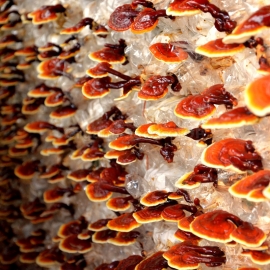 EXCLUSIVE
EXCLUSIVE



Reishi / Ganoderma lucidum - Organic Mushroom Spawn
6.10 €
Traditional and contemporary Chinese medicine admire it as a tonic benefiting vital energy or "Qi", and it is popularly prescribed for a multitude of maladies. Reishi is a polypore mushroom, growing in damp, dark forests and the occasional rotting log.
-
Reishi Organic Mushroom Plug Spawn
Reishi is that age old medicine cited thousands of years ago in several texts and scripts as being a tonic for emperors. At one time this mushroom was specifically used under the prestigious vestiges of the ruling class, but it has since made its way into the pantries of us common folk.
Traditional and contemporary Chinese medicine admire it as a tonic benefiting vital energy or "Qi", and it is popularly prescribed for a multitude of maladies. Reishi is a polypore mushroom, growing in damp, dark forests and the occasional rotting log. Modern day demand has forced its cultivation in Japan, China and the United States which is promising for the wild stands of Reishi.
What is mushroom plug spawn?
Mushroom plug spawn is spiral grooved hardwood dowels infused (inoculated) with a specific mushroom species, in thise case reishi or lingzhi mushroom (Ganoderma lucidum). The mushroom mycelium (the white, root-like network of cells) colonizes and penetrates the dowels as it consumes the lignins provided by the wood. These plugs are used to inoculate freshly cut hardwood logs, stumps, or rounds to create a fruiting mushroom colony that can produce mushrooms for many years! These colonies are commonly referred to as mushroom logs. After waiting approximately one year from inoculation, a well cared for log will produce mushrooms several times a year, for 3-5 years.
Making reishi mushroom logs
Use only recently cut, disease free hardwood logs of approximately three feet in length and four to six inches in diameter... about as long and thick as your leg. "Shii" is the Japanese name of the tree Castanopsis cuspidata that provides the dead logs on which it is typically cultivated in Japan. For those of us in North America, we find reishi mushrooms prefers common deciduous trees such as oaks and maples. In nature it is found on a wide variety of woods, typically on dead or dying trees, primarily on deciduous woods, especially oak, maple, elm, willow, sweetgum, magnolia, locust, and in the Orient, on plums. Found on stumps, especially near the soil interface, and occasionally on soils arising from buried roots.
Use disease free wood with the bark intact.
Prepare plug spawn inoculation sites by drilling d 1 cm, h 5-6 cm holes in a spiral pattern starting at one end of the log working towards the other. Space each hole approximately 4-6 inches away from the last. Number of holes will vary, for most logs 20-30 is good.
Inoculate the log by hammering the colonized plugs into each hole. Using a small punch to sink the top of the plug 1/4in or so below the bark surface is recommended.
Seal the inoculation sites by dripping melted cheese wax onto each hole. Cheese wax is easy to work with and can be melted in a double boiler. We use a small 2.5 quart crock pot dedicated to this purpose. Wax can be dripped on with a brush, distributed with a large dropper, turkey baster, or easy to use 10cc B-D inoculation syringes. A markable metal write-on tag can be stapled or tacked to the end of the log for long term identification.
Caring for reishi mushroom logs
Place logs in a shaded area and keep moist, creating stacks, or leaning against each other for support is best. Many report success with partially burying reishi logs in loose soil, so while we tend to recommend avoiding direct contact with soil for other mushroom log colonies, reishi may in fact benefit from this arrangement. Frequent and normal rainfall should keep them moist, but the logs may require a watering during dry spells. If the logs receive no notable rain for two weeks we recommend soaking them overnight in a tub or bucket filled with water.
Because of their lower humidity requirements, Reishi mushroom logs may also be grown "potted" indoors. Simply place one end of your log in a planter and fill with a mixture of sand and small gravel. "Water" your log at least once every two weeks by pouring water into the sand gravel mix, the log will soak it up. Mushroom conks and antlers will begin forming when the log has matured. Their slow and steady growth is fun to observe!
Logs inoculated in early Spring may produce mushrooms by Fall, but will typically take up to one year to mature. Once mature, shock logs into producing mushroom by soaking them overnight and covering with a tarp or blanket. Remove cover when small mushrooms begin budding, usually 3-5 days. This is best done in Fall and Spring as Reishi is a warm weather mushroom and will eagerly produce when temps are 70F-80F.
More information here
